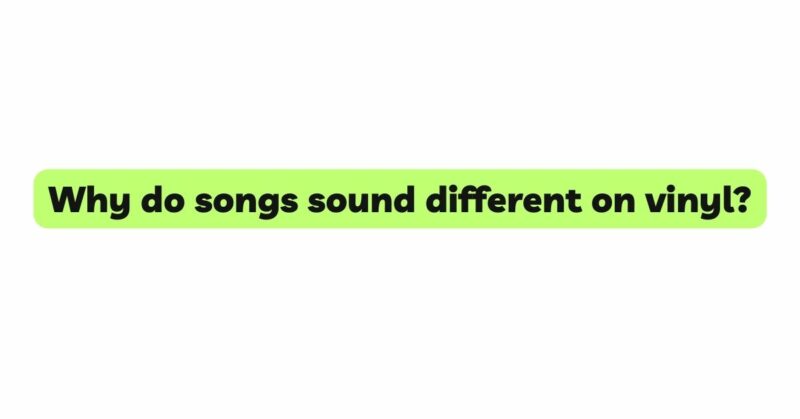As vinyl records make a remarkable resurgence in the modern music landscape, music enthusiasts are drawn to their unique analog sound and nostalgic charm. However, it is not uncommon for listeners to notice that songs sound different when played on vinyl compared to digital formats. This article aims to explore the reasons behind these differences, delving into the impact of analog sound, mastering choices, vinyl’s physical limitations, surface noise, emotional connections to vinyl, and the art of vinyl production, which collectively contribute to the distinct and captivating sound of songs on vinyl.
- The Analog Warmth of Vinyl:
One of the most celebrated attributes of vinyl records is their analog warmth. We’ll explore the concept of analog sound and how it creates a rich and immersive listening experience that sets vinyl apart from digital formats.
- Mastering for Vinyl:
Mastering for vinyl presents unique challenges compared to digital mastering. We’ll discuss how mastering choices, such as dynamic range adjustments and frequency response considerations, influence the sound of songs on vinyl.
- The Art of Analog Sound Reproduction:
Vinyl records rely on analog sound reproduction, emphasizing the artistry of music playback. We’ll delve into the technicalities of analog sound reproduction and its impact on the overall listening experience.
- Limitations of Vinyl:
Vinyl records have inherent limitations in terms of frequency response and dynamic range. We’ll examine how these limitations can affect the sound of songs when played on vinyl, particularly for songs with intricate details or wide dynamic ranges.
- The Impact of Surface Noise:
Vinyl records are susceptible to surface noise, which can add character and texture to the listening experience. We’ll discuss how surface noise influences the perception of vinyl sound and why some listeners find it endearing.
- Emotional Connections to Vinyl:
Vinyl records often evoke nostalgia and foster emotional connections to the music. We’ll explore how these emotional connections influence the way songs are perceived when played on vinyl, creating a more intimate and personal experience.
- Vinyl Pressing and Quality Control:
Vinyl pressing plays a crucial role in the final sound of songs. We’ll discuss the importance of high-quality pressings and how variations in pressing techniques can lead to different sonic results.
- The Subjectivity of Sound Perception:
Sound perception is subjective and varies among listeners. We’ll discuss how individual preferences, expectations, and listening environments can influence perceptions of vinyl sound quality.
- The Tactile Experience of Vinyl:
Playing a vinyl record is a tactile experience that engages multiple senses. We’ll discuss the significance of handling vinyl, watching the needle glide through grooves, and how this sensory experience contributes to the perceived differences in sound.
- The Coexistence of Vinyl and Digital Formats:
Vinyl and digital formats can coexist, offering different listening experiences. We’ll discuss how both formats cater to diverse preferences and how each contributes to the appreciation of music.
- Vinyl’s Role in the Modern Music Landscape:
In a digital age, vinyl remains a symbol of authenticity and a tangible link to music history. We’ll explore how vinyl’s unique sound and emotional appeal keep it relevant in the modern music landscape.
- The Appeal of Vinyl in Audiophile Culture:
Vinyl holds a special place in audiophile culture. We’ll examine how vinyl resonates with audiophiles who seek high-fidelity sound and value the artistry of analog playback.
- Addressing Variations in Sound:
Understanding the reasons for variations in sound between vinyl and digital formats can help listeners appreciate the unique qualities of each medium and make informed choices.
- The Future of Vinyl:
As vinyl continues to experience a revival, we’ll discuss its enduring appeal and potential for continued growth in the music industry.
Conclusion:
The distinct sound of songs on vinyl is a result of the analog warmth, mastering choices, vinyl’s physical limitations, surface noise, emotional connections, and the art of vinyl production. Vinyl records continue to captivate music enthusiasts with their nostalgic charm, evoking a sense of authenticity and preserving a tangible link to musical history. While songs may sound different on vinyl compared to digital formats, the appeal of vinyl lies in its ability to provide a rich and immersive listening experience that engages multiple senses. As technology continues to advance, both vinyl and digital formats will coexist, offering diverse listening experiences to cater to the unique preferences of music enthusiasts worldwide. Ultimately, the choice between vinyl and digital is a matter of personal taste, reflecting the individual’s values, connection to music, and desire for a more immersive and authentic musical journey.


